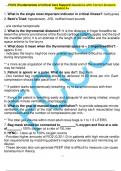Exam (elaborations)
Test Bank - Brunner & Suddarth's Textbook Chapter 49 of Medical-Surgical Nursing 14e
- Institution
- Baptist School Of Nursing
1. A nurse is caring for a patient with liver failure and is performing an assessment in the knowledge of the patients increased risk of bleeding. The nurse recognizes that this risk is related to the patients inability to synthesize prothrombin in the liver. What factor most likely contributes t...
[Show more]












